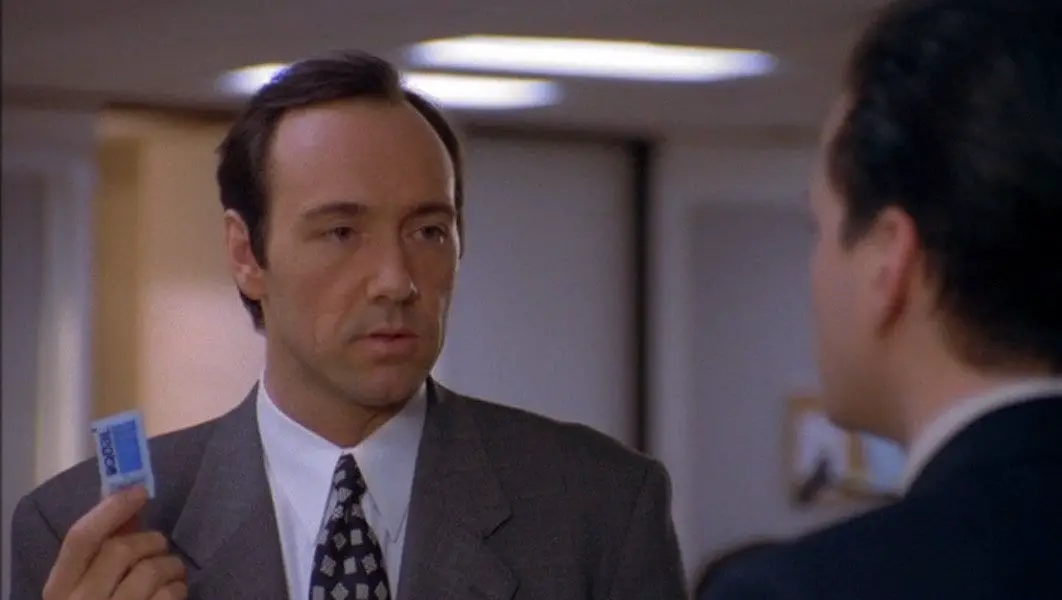I don’t think Swimming with Sharks would get made today, though we need to hear what it has to say now just as much as we did in 1994, if not more so. We all know about the abuse that has been endemic to the Hollywood system at this point—or we should—what with Harvey Weinstein, Kevin Spacey, and others having been exposed in the wake of #MeToo. This is what Swimming with Sharks explores, through the lens of our protagonist Guy (Frank Whaley), who suffers at the hands of his boss, Buddy (Kevin Spacey), turns to take revenge, and then ultimately gets caught in the same cycle of abuse; turning from victim to perpetrator.
Also, this is a comedy.

Some people struggle with black humor, which is precisely what Swimming with Sharks is. This isn’t satire, which takes reality and pushes it further; it is laughing at the silly movements of the man at the gallows who has just been hanged. One has to laugh not because things aren’t serious, but because they are so serious laughter is the only release. At its best, black humor gives us an entry into truths that otherwise might be too difficult to confront. Play it straight and we might just cringe and turn the thing off; show us the absurdity of it all, and maybe, just maybe, we can make it through; laughing in the face of the heinous rather than ignoring it.
Furthermore, I would suggest that there is a certain form of realism at play in the best instances of the genre. For example, a death in a drama is often presented in a way where it is taken very seriously, but this misses the banality of it. Death is always right there, a stopped heartbeat away. So I would suggest that those who struggle to appreciate black humor perhaps do so not because it is “making light” of dark topics, but because it is too realistic and the comedy of it eludes them. Each of us might die literally at any moment; isn’t that hilarious?
Of course, Swimming with Sharks doesn’t center on death, although the plot does meaningfully revolve around one. Part of the comic movement of the film is, nonetheless, to sideline this act of murder, which isn’t even shown. Because that’s how (un)important the woman is, here. Again, this is a comedy.
Depressingly, it would seem that when the film came out, some even took it as a primer: this is what to expect. Hollywood executives showed it to new recruits and so on. It’s hard for me to imagine a greater misunderstanding of a film’s intent, but so it goes…

After some preamble, we find Guy having tied Buddy to a chair to torture and vent against him. The film inter-cuts between this scene and the history of their relationship, from Guy’s first day as Buddy’s assistant forward. Buddy is horrible and incredibly abusive; railing on Guy for bringing him a packet of Equal instead of Sweet ‘n Low, telling him not to think but just obey, and so on. His job is to get Buddy whatever he wants—whatever it is—and this extends to Buddy’s desires for women. Make it happen or you’re fired is the basic through-line, without regard to whether any given request is reasonable, or ethical.
Enter Dawn (Michelle Forbes), who understands how intolerably abusive Buddy is, but needs him to make her projects go. In the first instance, it would seem this is why she wants to cozy up to Guy; he’s Buddy’s assistant and could potentially help her. But, the two hit it off and their relationship is a key part of the text.
I insist on reading this as genuine—Guy’s affection for Dawn and hers in return—as it makes the culmination of events all the more powerful. When, ultimately, Dawn enters the scene wherein Guy has Buddy tied to a chair and is thinking of killing him, he doesn’t. Instead, he kills Dawn. We don’t see it, though, because that’s not what this story is about. The fact that we don’t see it is funny.
What this story is really about is revealed in the final scene, where Guy has taken his place as one of the powerful men in Hollywood, about to have a meeting with Buddy. The latter has convinced him that having been abused in the past means he deserves the power to abuse others in the future; that the world is a cold place of self-interested power struggle. Love conquers nothing. Actually, it doesn’t exist. Dawn was just playing the game as well; using Guy to advance her own agenda. A brutal misogyny creeps into Buddy’s monologue.
Of course, this isn’t true. Whatever she may have done, Dawn wasn’t the malicious woman Buddy paints her to be. He claims she slept with men to get ahead, but even if the sex happened, it is clearly wrong to think of this as some kind of moral failing on her part, as if she were the instigator offering herself for career advancement. Rather, it’s a matter of what she had to do; like Guy with the coffee and the sweetener, but way worse.
Swimming with Sharks doesn’t focus on the struggles of women in Hollywood. It probably couldn’t be a comedy, however dark, if it did. But the thought is there. Dawn has put up with untold abuse to make it in the business. She believes in her projects, but needs assholes like Buddy to sign off on them. The choice is to go along or get washed out, or blacklisted. Maybe in the first instance she approaches Guy with her career in mind, but I have to believe, watching the film, that what they end up with is truer than that.

At the climax, Guy is presented with a choice: Dawn (who represents the hope of escaping the cycle of abuse and pursuing projects they care about while loving one another) or Buddy (who argues that that is all a fantasy; the real world is cruel and the best you can hope for is to be the one dishing it out).
I can’t help but think the names are symbolic, here. Guy is fundamentally just a guy who gets caught up in this thing. That’s not to suggest that he is forgivable, by any means. Rather, his choice is between Dawn (an opportunity at a new beginning, away from the structures of toxic masculinity) and Buddy (his abuser turned friend, who now offers him the same position of privilege from which to abuse others himself).
This is the dynamic: you put up with the shit and abuse to “pay your dues” and then you get your turn, much as Rex (Benicio Del Toro) informs Guy early on that he is moving on from being Buddy’s assistant to being an executive. It’s like that is your reward: be abused for long enough, well enough, and you can then become the abuser.
Of course that’s toxic, but it can also be alluring, and maybe even feel like justice. If you’re Guy (a guy) who has spent all of this time being shit on, isn’t there some appeal in the idea of being the one to give the shit?
But that’s the structure of toxic masculinity. This image is put forward as to what it means to be a (powerful) man and it exerts a force. Buddy gets what he wants. Don’t you want that, too, guy? Don’t you want that power to bend the world (and woman) to your will?
This is what we’re told it means to be a man: to dominate. This is what is toxic; not masculinity itself, but the version of it that holds up guys like Buddy as exemplars. If you’re a powerful man, you can do what you want; grab them by the pussy.
If that sounds appealing to you, you’ve been caught in the structure of toxic masculinity, like Guy. And it’s all too understandable, which is what Swimming with Sharks brings home. If you yourself have been abused, there is perhaps solace in taking up the role of the abuser. Or, again, maybe this feels like justice. Maybe it feels like because those forces have been keeping you down, and now you have a chance to flip the script; you’ve earned it.
But this is what’s toxic. Guy foregoes this chance at escape represented by Dawn, and instead embraces his place in the cycle. As such, though the film focuses on the power dynamics between these two men, something about gender is at least there in the background.

Dawn wants Guy to get out of the system that they are both trapped within, where people like Buddy call the shots. And she wants out, too. She sees the space for a new day to break out, but it ultimately feels like a fantasy. The structure re-exerts itself. Guy kills her and chooses Buddy. The song remains the same.
25 years later and we’ve hit a certain moment of hope. #MeToo has happened. Harvey Weinstein is (hopefully) going to prison (I need to check on that). Kevin Spacey has been called out—and, I must admit, those accusations, along with his super creepy video around Christmas of last year made me hesitate about writing about this film—fact is, though, no distance is needed here; if Spacey is a creep in real life, well, one can only hope he is not as bad as Buddy.
But, are things getting better? Weinstein has been exposed, as has Spacey, and any number of others. And, yet, Brett “I like beer” Kavanaugh was confirmed to the Supreme Court.
Al Franken resigned, but Mister “grab them by the pussy” is President.
By now, we’ve become well acquainted with anti-heroes and with stories where the bad guy wins. Swimming with Sharks is tougher because it’s a story where the “good guy” becomes a bad guy. The whole film encourages you to empathize with Guy, and then turns on you.
But, I think it does so precisely to illuminate this problematic structure where the abused turns into the abuser, and how a toxic image of masculine power exerts itself.
This is not power in terms of what one can do, it is power over others, serving some kind of psychological need I guess. It is to make oneself feel better by putting others down, and that is what’s toxic about it.
Yet, what Swimming with Sharks exposes is how easy it is to get caught up in this; or how hard it is to avoid it.
This is not to absolve Guy at all, on the contrary. But it is to think about these dynamics of what can lead men down such objectionable paths. Toxic masculinity is not masculinity, and anyone who takes the phrase to be claiming that masculinity is toxic needs to learn how adjectives work.
What is toxic is this structure of control; this idea, or image, that gets put forward in terms of what it means to be a man. What is toxic is the idea that someone like Buddy is a friend deserving of any respect; potentially someone to emulate. Fuck that, Guy!
We can break free of these expectations. We can start a new day if we do. All we need to do is to realize that this image of masculinity is bullshit. Buddy is an asshole, and Guy ends up one. But there is this space where Guy doesn’t do what we want him to. Unless you’re an asshole, didn’t you want Guy to choose Dawn?
The fact is that masculinity is not in itself toxic: it is a certain image, or model, of it, that is. If we hold up the images of Buddy, or Trump, as models, then we are lost. These aren’t men; they’re children.
It is not enough to call out individuals and leave the structure in place. Weinstein, Spacey, others, sure; but have we changed the systemic problem?
This is what Swimming with Sharks gets at. This is the point. It’s black humor, sure, and you could well look at it now and think that somehow this thing back in 1994 was making light of something we now take to be super serious, but you’d be missing the point.
Because to laugh with it then was as hard as to laugh at it now. Things haven’t changed that much, and that’s the depressing bit.


